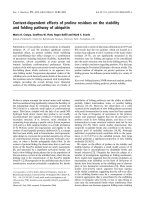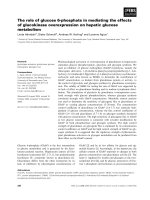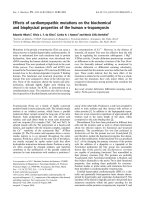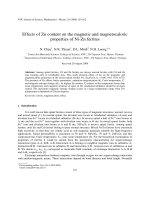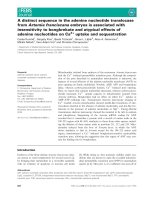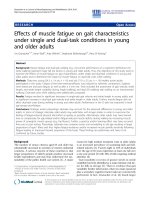Examining the effects of extracurricular activities on academic achievement, attendance record, and learner engagement among the english majored students in huflit graduation paper
Bạn đang xem bản rút gọn của tài liệu. Xem và tải ngay bản đầy đủ của tài liệu tại đây (642.64 KB, 48 trang )
Ministry of Education and Training
HO CHI MINH CITY UNIVERSITY OF
FOREIGN LANGUAGES AND INFORMATION TECHNOLOGY
------------------------DEPARTMENT OF FOREIGN LANGUAGES
GRADUATION PAPER
EXAMINING THE EFFECTS OF EXTRACURRICULAR ACTIVITIES
ON ACADEMIC ACHIEVEMENT, ATTENDANCE RECORD, AND
LEARNER ENGAGEMENT AMONG THE ENGLISH-MAJORED
STUDENTS AT HUFLIT
Submitted by: Nguyen Thi Hong Tuoi
Student ID:
14DH710024
Major:
Business English
Supervisor:
Mr. Nguyen Thuong Tri, M.A.
Ho Chi Minh City - 2019
DECLARATION
I certify that the attached material is my original work. No other person’s work
or ideas have been used without acknowledgement. Except where I have clearly
stated that I have used some of this material elsewhere, I have not presented
this for assessment in another course or unit at this other institution.
Date: June 18th, 2019
Name/signature
i
ACKNOWLEDGMENTS
I wish to express my sincere gratitude for prestigious guidance of MA. Nguyen
Thuong Tri. Additionally, I would also like to express my deepest thanks to
Foreign Languages Department at HUFLIT, MA. Nguyen Thanh Tu in
particular, for their cooperation in data collection process.
June 18th, 2019
ii
TABLE OF CONTENT
DECLARATION ............................................................................................ i
ACKNOWLEDGMENTS .............................................................................. ii
LIST OF TABLES ........................................................................................ iv
LIST OF FIGURES ........................................................................................ v
LIST OF ABBREVIATIONS ....................................................................... vi
ABSTRACT ................................................................................................... 1
CHAPTER I: INTRODUCTION.................................................................... 2
CHAPTER II: LITERATURE REVIEW........................................................ 4
2.1.
Definition of EAs ............................................................................... 4
2.2.
The relationship between EAs and academic performance ................. 4
2.3.
Need for the present study .................................................................. 7
CHAPTER III: METHODOLOGY ................................................................ 9
3.1.
Methods ............................................................................................. 9
3.2.
Setting and Study Sample .................................................................. 9
3.3.
Procedures ....................................................................................... 10
3.4.
Statistical Analysis ........................................................................... 10
CHAPTER IV: RESULTS ........................................................................... 12
4.1.
Overall views on student involvement in EAs. ................................. 12
4.2.
Outcome differences across the student roles in EAs ....................... 18
CHAPTER V: FINDINGS AND DISCUSSION .......................................... 30
CHAPTER VI: EVALUATION AND RECOMMENDATIONS ................. 33
5.1.
Strong points of the study................................................................. 33
5.2.
Limitations ....................................................................................... 33
5.3.
Recommendations ............................................................................ 34
CHAPTER VII: CONCLUSION .................................................................. 36
REFERENCES............................................................................................. 37
APPENDIX .................................................................................................. 39
iii
LIST OF TABLES
Table 1: Sample distribution by gender, major, year at university ................ 12
Table 2: Impacts of involvement in EAs on organizers’ GPA classification,
attendance rate, and learner engagement (from the highest to the lowest
ranking means of the organizer group) ......................................................... 19
Table 3: Level of organizers’ involvement in EAs........................................ 20
Table 4: Impacts of involvement in EAs on leaders’ GPA classification,
attendance rate, and learner engagement (from the highest to the lowest
ranking means of the leader group) .............................................................. 22
Table 5: Level of leaders’ involvement in EAs ............................................. 24
Table 6: Impacts of involvement in EAs on participants’ GPA classification,
attendance rate, and learner engagement (from the highest to the lowest
ranking means of the participant group) ....................................................... 25
Table 7: Level of participants’ involvement in EAs ...................................... 26
Table 8: Impacts of involvement in EAs on observers’ GPA classification,
attendance rate, and learner engagement (from the highest to the lowest
ranking means of the observer group)........................................................... 28
Table 9: Level of observers’ involvement in EAs ......................................... 29
iv
LIST OF FIGURES
Chart 1: Academic performance ................................................................... 13
Chart 2: Attendance record ........................................................................... 14
Chart 3: Level of involvement in EAs .......................................................... 15
Chart 4: Learner engagement ....................................................................... 17
Chart 5: Sample distribution by the student roles
(Organizer and non-organizer group) ........................................................... 18
Chart 6: Sample distribution by the student roles
(Leader and non-leader group) ..................................................................... 21
Chart 7: Sample distribution by the student roles
(Participant and non-participant group) ........................................................ 24
Chart 8: Sample distribution by the student roles
(Observer and non-observer group) .............................................................. 27
v
LIST OF ABBREVIATIONS
EAs:
Extracurricular activities
GPA:
Grade Point Average
HUFLIT:
Ho Chi Minh City University of Foreign Languages
– Information Technology
SPSS:
Statistical Package for the Social Sciences
vi
ABSTRACT
Although a huge plethora of research has shown that student involvement in
extracurricular activities (EAs) is overwhelmingly beneficial to developing
well-rounded individuals in the educational environment, there is an
assumption that EAs distract them from their primary duty as a student, thus
leading to lower academic performance. This study examined grade point
average (GPA) classification, attendance record, and learner engagement
among English-majored students at Ho Chi Minh City University of Foreign
Languages – Information Technology (HUFLIT). A total of 100 Englishmajored students participated in this study during the second semester of the
academic year 2018 – 2019 to determine if there is a negative correlation
between EAs and student responsibility. The research divided the sample into
four groups: organizer, leader, participant, observer. Mann Whitney U Test and
descriptive statistics were used to give a breakdown of collected data with
assistance of statistical package for the social sciences (SPSS). The findings
show that the most active group (leader) has noticed much more positive impact
of EAs on their confidence and enthusiasm for learning, compared to nonleader groups. Although larger time commitment to EAs did make leaders skip
class more frequently than non-leader population, their absenteeism can be
justified by many reasons. Further research is needed, but the findings of this
study partially dispel some doubts about the positive impact of EAs, providing
educators stepping stones to boost academic outcomes through promoting outof-class activities.
1
CHAPTER I: INTRODUCTION
As the 21st century is the era of intellectual civilization with rapid growth
in the field of science and technology, Vietnam is facing great opportunities as
well as challenges to successfully adapt to the 4.0 industry. The development
of modern industry and national construction requires us to create high-quality
human resources. As a condition for the basic element of this revolution,
educational development is one of the driving forces of industrialization and
modernization. One proven factor greatly affecting all the prerequisite
conditions to boost academic growth is EAs in schools. Being aware of the
importance of EAs, HUFLIT has promoted a wide range of beneficial and
interesting activities over recent years. More specifically, school leaders always
encourage students to devote themselves to EAs which are designed to endow
students with qualities to meet the expectations set by social standards.
Dynamism and creativity, therefore, are the most striking and distinguishing
features of undergraduates and graduates at HUFLIT.
The positive benefits attract the interest of many educational leaders and
policy makers seeking ways to enhance student’s development. Most
individuals seem to agree that EAs will continue to hold an important role in
education. As noted in the research conducted by Massoni (2011), positive
effects commonly include positive thinking, better scores, school completion
[10]. Bakoban et al. (2015) indicated that EAs offered by universities play an
essential part in the academic advancement [3]. Likewise, An et al. (2016) also
identified the positive effects of student participation on the academic results
at Can Tho University of Technology [1].
The primary duties of students at colleges, however, is to receive
academic knowledge and earn a degree. It is not surprising then that
undergraduates tend to prioritize academic duties rather than EAs. Although it
2
is worth noting that student involvement is overwhelmingly beneficial to
developing well-rounded students, there is a widely held assumption that EAs
require too much time and effort, thus ultimately hinder students from
performing well at schools. A study conducted by Harnett (1965) supported
this claim. The research discovered that lowered student achievement can be
originated from too much involvement in EAs [9]. Other noticeable research
done by Braden (2017) emphasized that decreasing outcomes of engagement
in EAs when students cannot adapt to finding a balance between school duties
and out-of-class activities [5].
Like many other pieces of research, most findings only focus on the
impact of EAs on student learning outcomes overseas while little work carried
out to identify the possibility of distractions from school work caused by EAs
in Vietnam. Due to the significance of the issue, lack of empirical surveys to
measure the effects of EAs offered by private universities in Vietnam, this
research aims to measure and identify the impact of EAs on student
performance.
3
CHAPTER II: LITERATURE REVIEW
2.1.
Definition of EAs
Due to the lack of a generally accepted definition of EAs, a study
conducted by Bartkus et al. (2012) pointed out several key points neglected by
prior research. This study examined many representative examples and
descriptions of EAs from various prestigious press to clarify its meaning. Using
meticulous analysis, researchers proposed a working definition:
Extracurricular activities are defined as academic or non-academic activities
that are conducted under the auspices of the school but occur outside of
normal classroom time and are not part of the curriculum. Additionally, EAs
do not involve a grade or academic credit and participation is optional on the
part of the student [4].
2.2.
The relationship between EAs and academic performance
2.2.1. Positive impact of EAs on academic performance
According to American Journal of Business Education, Bakoban and
Aljarallah (2015) conducted a study on 239 undergraduates on Faisalian
campus at King Abdulaziz University. Employing both quantitative and
qualitative methods to access the impact of EAs on the students’ GPA,
researches revealed that participation in EAs has tremendously positive effects
on school works. The study also pointed out a relatively high level of
satisfaction of available EAs on the campus among their sample study [3].
A study conducted by Salmeen et al. (2019) supported the abovementioned findings. Their sample survey consisted of 100 female students from
various majors at Jubail University College. A questionnaire was distributed
electronically among the students to investigate the impact of EAs on student
performance. The findings of the research showed that involving in EAs
generally improves the students’ academic performance [13].
4
In Can Tho University Journal of Science, An et al. (2016) went further
and provided a profound insight into factors affecting academic achievement
of undergraduates. Their sample survey consisted of 561 random freshmen or
sophomores at Can Tho University of Technology. With Exploratory Factor
Analysis, researchers found that those who involved in EAs have GPA than
those who did not [1].
Higher level of satisfaction with EAs and better academic achievement
can be obtained by participating in majored-related activities, as suggesting by
a thought-provoking review of Correa et al. (2015). Published on Global
Advanced Research Journal of Educational Research and Review, this study
explored a number of literature works on the collaboration between EAs and
learning outcomes of university students. Consulting a vast array of the greatest
scientific research, Correa drew an interesting conclusion that not all EAs have
positive effects on academic performance. It is essential to note that the
outcomes of student involvement vary across activities and benefits of EAs do
not come at the expense of classroom engagement [6].
Excitingly, this recommendation was closely aligned with the results of
the master’s thesis done by Reva at University of Saskatchewan in 2012. This
study aimed to identify the role of EAs in foreign language learning in
university settings. The total of 119 undergraduates and 14 language instructors
at universities in Russia and Canada participated in the questionnaire study.
Using both quantitative and qualitative methods, the researcher found that
language-oriented EAs play a critical part in foreign language programs and
student life [12].
5
2.2.2. Counterproductive impact of EAs on academic performance
Braden (2017) provided a comprehensive literature review on the
association between EAs and academic achievement on the BYU
Undergraduate Journal in Psychology. The study suggests that involvement in
EAs may endow students with feelings of belonging and sense of personal duty
which assist students in classroom engagement. Researcher, however,
encourages us to be wary of excessive involvement. The overloaded personal
schedule may lead students to define themselves firstly by their achievement in
EAs instead of academic success [5].
More interestingly, Nelson-Addy (2017) shed important insights into the
effects of Symposium on school work in her Master’s dissertation at Oxford
University. Ten students at Eden High School were directly interviewed to gain
deeper into their perspectives. Although the sample seems to be excluded from
the merits of Symposium, the researcher found that EAs, or more specifically,
Symposium, stimulate students’ interest and self-assurance which shortly yield
positive impact on academic performance. Student involvement in EAs,
however, seems to have had a detrimental effect on a small minority of students
who preferred the way they learn in EAs more [11].
These findings might be reverse to Hawkins’ study. In the master’s thesis
(2010), Hawkins explored the relationship between undergraduate student
activity and academic performance. This study included a sample of 28148
general students, 8664 organization members and 1583 organization officers.
Using the quantitative method, the results indicated that students in charge of
organizing EAs tend to gain better GPA despite larger time commitment [8].
6
2.2.3. Debate over the relationship between EAs and academic
performance
While a plethora of research showed the strong correlation between EAs
and academic outcomes, some famous studies suggested that activity
involvement is only loosely related to classroom engagement. Specifically, AlAnsari et al. (2015) conducted research to explore factors affecting student
participation in EAs. The survey covered a representative sample of two dental
schools, with 199 and 143 undergraduate students in Alexandria and Dammam
respectively. Employing the qualitative method, researchers finally concluded
that the collaboration between EAs and study is really weak [2].
This finding is in line with research conducted by Siti et al. (2015) on the
effects of EAs on academic achievements among the public university students
in Malaysia. The sample consisted of 150 students who are randomly selected
from the three public universities in Peninsular Malaysia. Employing the
quantitative method, this study indicated that involvement in EAs has
insignificantly positive effects on student’s academic achievements [14].
More importantly, Green (2009), a renowned researcher at University of
South Florida, went further and clarified both barriers and facilitating factors
to students’ school engagement. According to this doctoral dissertation, 1522
students randomly chosen from four high schools in Pinellas County School
District were involved in the survey. Surprisingly, activity participation was the
least likely to stimulate the students’ school engagement while support from
adults at school was deemed a chief factor assisting the sense of belonging [7].
2.3.
Need for the present study
Despite a plethora of evidence for positive correlation between EAs and
academic outcomes, there is a widely held assumption that commitment to EAs
might lower student performance at schools. Unfortunately, this assumption
7
can force students refrain from participating in EAs. In the meantime, the
corroboration for positive impact of EAs is still inconclusive even though it has
been the stepping stone of the present study.
In short, I hope that the keys to the following questions will be found in
the research conducted at HUFLIT:
1. Do EAs hinder students from performing well at schools in terms of
GPA classification, attendance rate, and learner engagement?
2. Are there any differences in GPA classification, attendance rate, and
learner engagement across different roles of students in EAs?
To explore the answer to the second question, the research divided the
roles of students in EAs into four groups: organizer, leader, participant, and
observer.
8
CHAPTER III: METHODOLOGY
3.1.
Methods
Quantitative research method was selected for investigating the opinions
and experiences of students. It allows the researcher to collect more data within
the limited amount of time, compared to a one-to-one interview. Additionally,
this survey method provides more general views of students on the EAs’
effects, hence data validation.
A questionnaire survey was developed in both Vietnamese and British to
make sure that all participants comprehend the questionnaire prudently and
thoroughly. The form comprises of two sections: demographics and EAs’
impact.
Section 1 totally contains eight questions in total. Seven multiple choice
questions relating to gender, major, year of program, GPA, participant’s
position, average weekly participation hours and missed classes due to activity
participation. To ensure that the answer is not repeated, this part solicited
information about students’ email address through an opened-ended question.
Section 2 has a set of 10 statement relates to learner engagement at
school. These questions allowed students to rate the effectiveness of EAs
following the five-point Likert scale, ranging from (1) – which indicates
Strongly disagree to (5) – which indicates Strongly agree.
The questionnaire was approved by the university teachers for its aim
and moral standards. No comment related to the ambiguity of question contents
were reported.
3.2.
Setting and Study Sample
The study was conducted in HUFLIT, a private school in the South of
Vietnam. With respect to the score of the entrance exam, English Language - a
leading academic program - has remained on top of the other faculties at
9
HUFLIT for recent years. HUFLIT has promoted a wide range of beneficial
and interesting activities over recent years. More specifically, school leaders
always encourage students to devote themselves to EAs which are designed to
endow students with qualities to meet the expectations set by social standards.
Dynamism and creativity, therefore, are the most striking and distinguishing
features of undergraduates and graduates at HUFLIT.
The research targets were English–majored students who participate in
EAs. At HUFLIT, students have to complete four academic years (not
including summer sections) to earn the Bachelor degrees. In the English
Language program, there are totally five majors (Interpretation and Translation,
Business English, Pedagogy of English, Office Administration and English –
Chinese Bilingual Program). Students included in this study were in the second
semester of the 2018-2019 academic year. All of them have access to the
internet and use Facebook as a popular form of communication.
3.3.
Procedures
The questionnaire was constructed and distributed electronically using
Google forms. For ensuring the objective of these findings, researcher sent the
link of the form via Facebook pages which is under the school administration.
As the forms were filled in anonymously, students confidently express their
opinions without fear for embarrassment or being judged. Student responses
were gathered from 13rd to 27th April 2019. They could not get access to the
form to answer the questions after the due date. The survey questionnaire is
included in the Appendix.
3.4.
Statistical Analysis
After the general survey, the raw data will be collected and organized in
Excel, then imputed and analyzed in the computer software program SPSS,
which is widely used for the entry and management of various categories of
10
data. The significant level was set at 0,05 for the whole statistical test. First,
frequency analysis was selected to give a breakdown of demographic data and
impact of EAs on the whole sample. Second, the differences across the study
sample (four groups: organizer, leader, participant, and observer) were
analyzed with the assistance of Mann Whitney U Test.
The independent variable is the roles of students in EAs (organizer,
leader, participant, and observer). The dependent variables are GPA
classification, attendance rate, and learner engagement. The processed data are
shown in Chapter 4, along with some interpretations.
11
CHAPTER IV: RESULTS
4.1.
Overall views on student involvement in EAs.
4.1.1. Demographic data
After the due time, the research received 103 responses via the Google
forms. Taking into account some overlapping email addresses, a total of 100
student responses were considered valid data for the study. Table IV. shows a
breakdown of demographic information
Table 1: Sample distribution by gender, major, year at university
Demographic information
Gender
Percentage
Male
13%
Female
86%
Other
Major
Year at
university
1%
Business English
50%
Pedagogy of English
25%
Translation and Interpretation
14%
Office Administration
8%
English – Chinese Bilingual Program
3%
Freshman
32%
Sophomore
31%
Junior
14%
Senior
20%
Other
4%
The table 1 indicates the demographic information of participants in this
study. From an overall perspective, it is clear that there are striking differences
in terms of the sample distribution by gender, major, year at university.
To be detailed, most responders (86%) are female, which subjectively
reflects the realities of the student population in language classes. The number
12
of participants from Business English was by far the greatest, constituting up
to precisely a half of the total on average, followed by Pedagogy of English and
Translation and Interpretation with 25% and 14% respectively. The two
remaining majors only occupied meagre proportions of the total.
It is noticeable that the numbers of freshmen and sophomores
participated in EAs are the highest in the research despite their lower familiarity
with school activities compared to juniors and seniors.
4.1.2. Academic performance
In the question: ‘Which group is your GPA in?’, the researcher used a
rating scale from 1 to 6 (where 1 is ‘Fail (0-4)’, 2 – ‘Almost fair (4-6)’, 3 –
‘Fair (6-7)’, 4 – ‘Fairly good (7-8)’, 5 – ‘Good (8-9)’, 6 – ‘Excellent (9-10)).
The ranking mean for the question was 3.44/5.
Chart 1: Academic performance
13
Chart 1 demonstrates the GPA distribution by six categories ranging
from ‘Fail’ to ‘Excellent’. From an overall perspective, considerate difference
across six categories of GPA were clearly observed. As indicated from the
chart, the most frequently reported answers were ‘Fair’ and ‘Fairly good’, with
39 and 37 respectively. Interestingly, ‘Almost fair’ and ‘Good’ occupied
precisely equal number, 10 for each category. The two remaining categories,
‘Fail’ and ‘Excellent’, constituted a meagre figure, with 3 and 1 respectively.
4.1.3. Attendance
In the question: ‘How often do you skip class due to participation in
EAs?’, the researcher used a rating scale from 1 to 5 (where 1 is ‘Never’, 2 –
‘Rarely’, 3 – ‘Sometimes’, 4 – ‘Often’, 5 – ‘Always’). The ranking mean for
the question is 1.67/5.
Chart 2: Attendance record
14
Chart 2 indicates the level of missed classes due to involvement in EAs
by five categories, ranging from ‘Never’ to ‘Always’. From an overall
perspective, considerate difference across five categories of attendance rate
were clearly observed. To be more detailed, over a half of student responses
were ‘Never’ (56), while ‘Often’ and ‘Always’ made up an insignificant figure
(1). The number of students rarely and sometimes skipped classes due to
involvement in EAs were 24 and 18 respectively.
4.1.4. Level of involvement in EAs
In the question: ‘How much time do you spend on EAs per week?’, the
researcher used a rating scale from 1 to 4 (where 1 is ‘Less than 5 hours’, 2 –
‘5-10 hours’, 3 – ’10-15 hours’, 4 – ‘More than 15 hours’). The ranking mean
for the question was 1.3/5.
Chart 3: Level of involvement in EAs
15
Chart 3 illustrates the level of involvement in EAs by four different
categories. From an overall perspective, considerate difference across four
categories of involvement level were clearly observed. As shown in the chart,
the number of responders who spent less than 5 hours on EAs per week was
recorded as the greatest (78), followed by the number of students spent 5-10
hours (20). The two remaining categories constituted a meagre figure, 2 for
each category.
4.1.5. Learner engagement
The results demonstrating subjects’ ranking of different statements of
learner engagement section are presented below in Chart 4. The table shows
learner engagement ranking with a rating scale from 1 to 5 (where 1 is ‘Strongly
disagree, 2 – ‘Disagree’, 3 – ‘Neutral’, 4 – ‘Agree’, 5 – ‘Strongly agree’).
Chart 4 shows the ranking mean for each statement from the highest to
the lowest. Overall, it is clear that all the ranking means were above 3.0
(Neutral) and below 4.0 (Agree). To be more specific, language acquisition
gained by far the greatest ranking mean (3.87) while responsibility for
homework was at the bottom of the list (3.24).
16
Chart 4: Learner engagement
Language acquisition
3.87
Useful background information applied in
the class
3.83
Confidence in public
3.82
Teamwork skill
3.73
Active listening
3.65
Enthusiasm for studying
3.6
Leadership skill
3.52
Responsibility for self-study
3.45
Sense of belonging
3.39
Responsibility for homework
3.24
1
2
3
Mean
17
4
5
4.2.
Outcome differences across the student roles in EAs
4.2.1. Organizer group
Chart 5: Sample distribution by the student roles
(Organizer and non-organizer group)
Chart 5 illustrates the student population by the roles in EAs (Organizer
and non-organizer group). As shown in the chart, the number of students in the
organizer group was 9, while the figure for the other group was 91.
18

